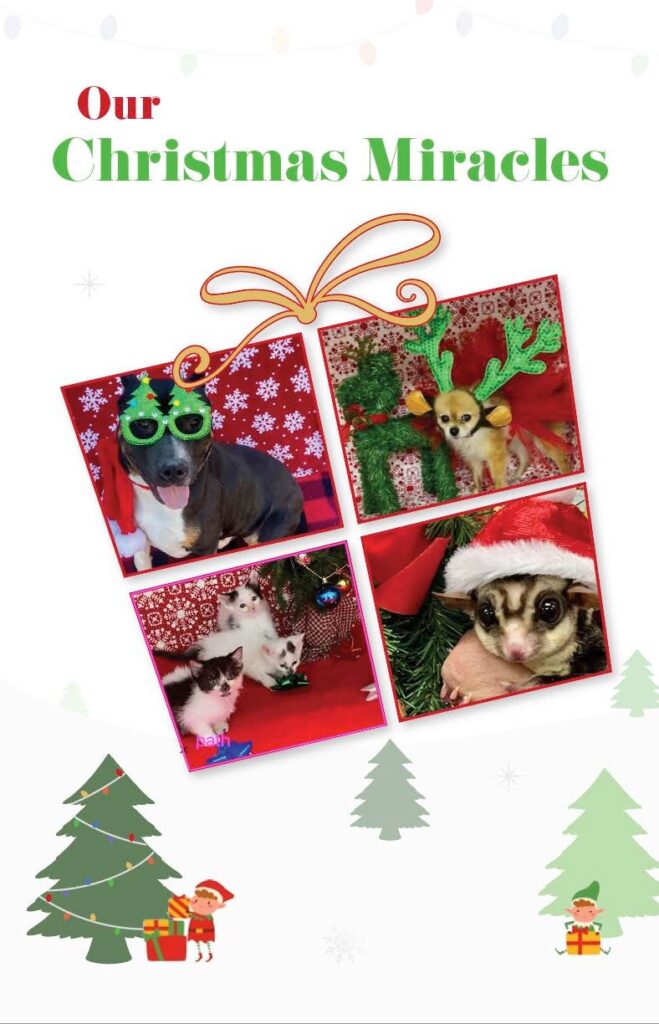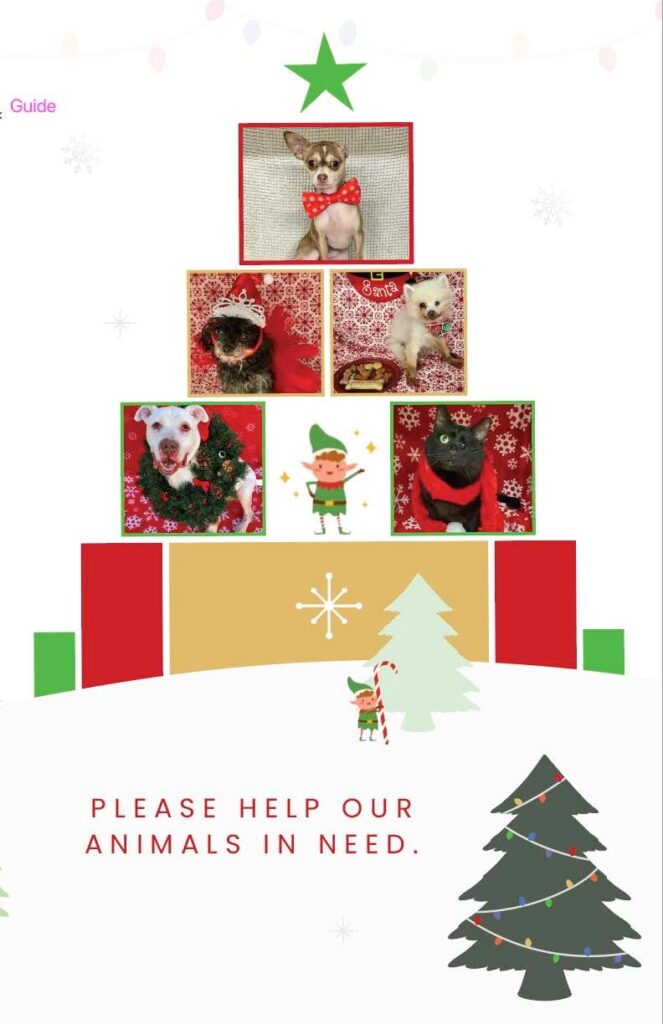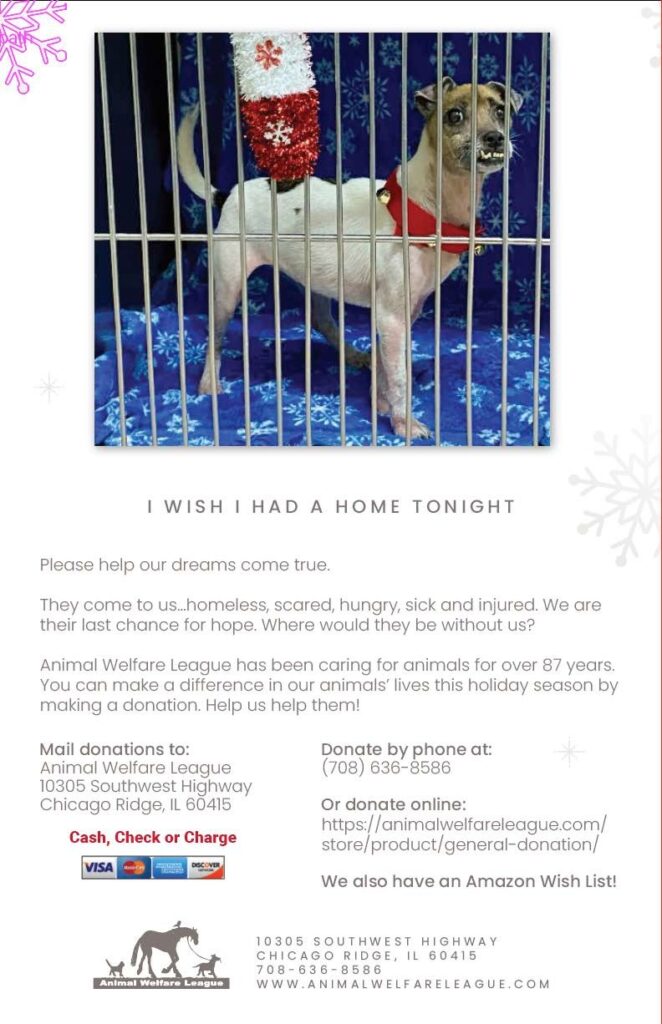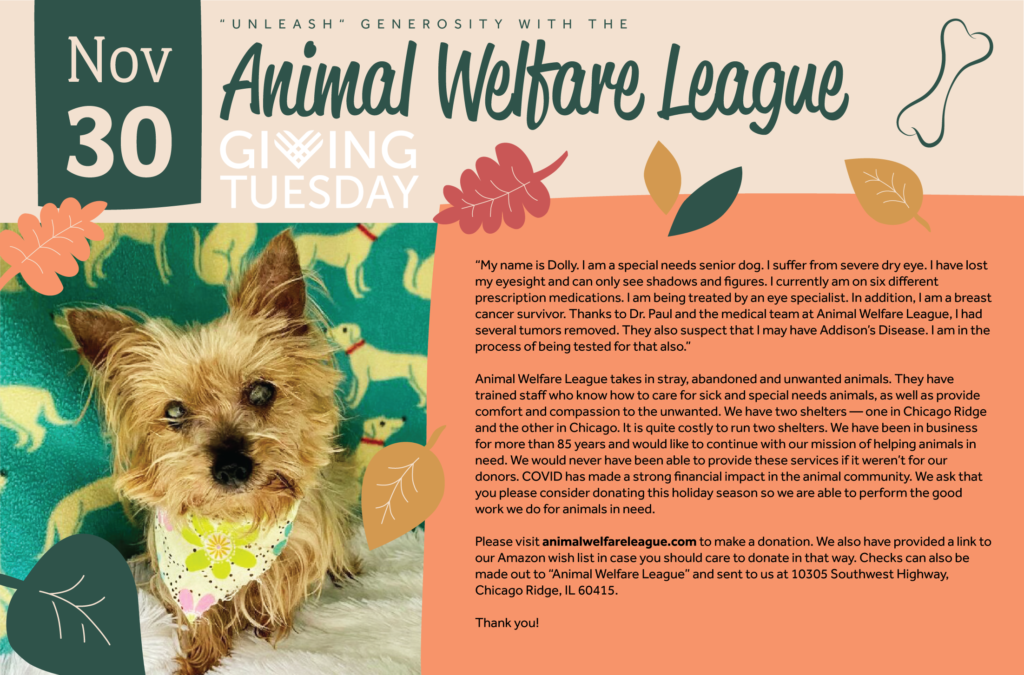











Dear Friends & Supporters
We have recently come under attack again by some animal rights activists. This recent attack comes about by our refusing to allow a blogger to take pictures of a young pit bull that we took in, following it’s rescue from a garage fire that occurred in Country Club Hills in late July of this year.
The dog was suffering from extreme smoke inhalation and, upon its arrival, was put under pulmonary therapy to ease its breathing and accelerate repair of damage to its lungs. At the time of its intake, a blogger who specializes in the reporting of fire activity in the southwest suburban area came to our clinic and demanded to see the dog and take pictures of it for his blog. We refused his request and explained to him that damage to the animal’s lungs may create a greater risk of infection, and that the dog was, for this reason, in quarantine, receiving oxygen therapy. In addition, AWL, like all animal shelters, have no idea of what the overall health of any animal arriving at our shelter is when it is first arrives at our door.
Common sense would allow for most people to realize that a shelter that houses many animals would be grossly irresponsible if it did not first have a veterinarian assess the health of any animal brought to its door without knowledge of its owners, or identity tags verifying that the animal has been vaccinated for prevention of deadly disease. All such animals (and we receive many) must be assessed by our veterinarian to ensure they are in good health before they can be placed in areas where other animals are housed. Also, by law, AWL and all other shelters in Illinois are required to hold all stray animals brought to them, for a period of time reasonable enough for the owner of the dog to come to the shelter to claim it. In other words, when we take in a stray dog, we realize it may have an owner out there who is seeking to reunite with their pet. For this reason, we treat that animal in a manner that any loving pet owner should and would want for their lost pet. If it needs medical attention, we provide that. We also ensure it is properly fed, comfortable, and that notice of the dog being brought to our shelter is properly made to the public and the animal is protected as we await notice from its owners.
Unfortunately, we often have individuals come to our facility and claim ownership of animals we take in, who we later determine are not the actual owners of the animal. Sometimes it is an honest mistake where someone sees the picture of the animal on our lost pet post and truly believes it is their lost animal. Sometimes however, it is someone who just likes the looks of the animal and wants it. This is why AWL and other shelters strongly encourage pet owners to have their animals protected with implanted microchips or another type of indelible identifying mark.
In cases where the animal has no implanted chip or identifying mark, we attempt to withhold information that we may have about the animal so that we can ensure that it is turned over to its true owner. For this reason, we encourage law enforcement, news media, as well as the public, to not publish detailed photographs of the animal or describe what collars or other items the animal may have upon them. It is important that we withhold such information so that the true owner of the animal can identify these items and provide proof of ownership.
When an animal suffers a traumatic event that makes it into the media, AWL has received dozens of calls from individuals, some calling from far away states, who insist the animal in question is theirs. This not only makes our job of reuniting the animal with their rightful owner more difficult, but it has also resulted in accusations appearing on social media from some people who insist we got it wrong and gave their dog away to someone who was not the rightful owner.
For this reason, we do not allow the news media or internet bloggers immediate access to the animals that are brought to our facility. Even though AWL may benefit from the publicity that may come to us through our efforts to treat such injured animals brought to us, our priority must be to ensure that the owners of the pet, who may be frantically trying to find their lost animal, be reunited with it.
This has made more than a few journalists and bloggers angry. We understand that they want to be first to report on a breaking news story and they very much want to include pictures with that story. But our job is to return lost animals to the people that the animal belongs with. Unfortunately, this sometimes results in posts that accuse us of all sorts of nasty and nefarious things. Posts have been made that we purposely killed the animal, or we sold it on some sort of black market. While all such accusations are inane to rational people, unfortunately, social media has become a gateway for the irrational.
We have come to live with all these accusations because we have the privilege of being there when a lost animal is reunited with its real family. AWL has been doing this for nearly a century now, and after all that time, and with all that experience, the community has come to know us and to trust us.
We honor and cherish the trust that you have in AWL. I promise that we will work every day to keep your trust and to do what is absolutely the best thing we can for lost and stray animals that are brought to us.
Before I close however, I want to bring to everyone’s attention the fact that our mission here at AWL is not, and never has been, to supply the public with pets. Our mission it to find good homes for the animals in our care. Unfortunately, that makes us unique, and because of that, it makes it difficult for people who have experience with other rescues and shelters to understand just how we operate.
So, allow me to explain.
Since the 1980’s, we have seen a boom in the opening of rescues and with animal advocates on social media telling the public and public officials how to eliminate the suffering of stray dogs and cats. Unfortunately, in all this time – over forty years – the problem has only grown worse.
During this time, the Animal Welfare League and other open shelters have been maligned, ridiculed, and defamed by these advocates who have not delivered upon their promise and, in fact, have fostered a growing problem that is today causing more harm to homeless animals than ever before.
America’s shelters and rescues are filled to the brim, we see and read of more dog attacks, illegal organized animal fighting still exists, and we have come to see outbreaks of deadly viral disease killing dogs and cats on an annual basis.
The most common criticism of AWL we see on social media is that we refuse to allow some people to adopt animals. I want you to know that the assertion that we turn people away is true. We do discourage some people from adopting pets. We always have and we always will.
The problem we have with too many stray animals in America is not an animal problem, it is a people problem. The only way we will eliminate this growing problem is to not encourage people who cannot properly care for an animal, to have an animal. It is not, as these advocates shout, to put an animal into every person’s hand. They have tried this for over forty years, and it is making matters worse.
AWL was founded to care for animals – not people. We are not in the business of providing people with pets, we are in the business of finding good homes for the animals in our care. Today, with inflation rates soaring, the cost of properly maintaining a dog in one’s home is nearing $6 thousand per year. Food, veterinarian costs, and grooming costs have all risen greatly over the past few years. Unfortunately, the wages of most Americans have not kept pace. Less people today can afford to properly care for an animal than just a few years ago, and many of these people are turning their pets over to rescues and shelters. Nearly every rescue and shelter we know of is filled to the brim with animals looking for adoption.
What good is accomplished by giving a dog or cat to someone who cannot afford to take care of that animal? According to CarPrice.com, 2023 repossession of automobiles from subprime borrowers has increased by 11 percent since 2020. This percentage is expected to rise further because the cost of auto loans is increasing. Ask yourself, if you were faced with losing your car or no longer spending money on the care of an animal, what would you do?
Clearly, I am not trying to compare the value of automobiles with family pets, I am trying to alert everyone in the animal care industry that American’s are facing difficult economic times. According to Epiq Bankruptcy, in August of this year, Chapter 11 bankruptcies increased 54 percent. From experience we know, when times get tough, animal shelters see an increase of wonderful dogs and cats, voluntarily turned in to them by owners who simply can no longer afford to care for them.
Asking potential adopters if they can afford the years long care of an animal may seem like a tough question to ask, but it is a question we must ask, and a question that every rescue and shelter should ask to people seeking to adopt an animal. Placing all your energy on clearing cages and not taking the time to determine if the person seeking adoption can afford to care for an animal is a major cause of the stray and abused dog problem we have in America. We see these animals turn up again at our door, or in some other rescue, shelter, or on the street.
Today, people are afraid of rising crime in our cities. We see this by the rise in potential adopters seeking dogs for protection. Interest in Pit Bulls, German Shepherds and other bully breeds is growing along with the fear that people are experiencing. But since the 1980’s we also see an increase in the attacks on people from dogs of these same breeds. And because of this, pit bulls, shepherds, and other large breeds were left to languish in cages at shelters and rescues, because they garnered fear and a bad reputation.
Pit Bulls, German Shepherds and other bully breed dogs make wonderful and adoring pets, when they have not been abused and are put in the hands of owners who can meet the needs of high energy and powerful dogs.
There is a lot of truth in the old saying that there are no bad dogs, just bad dog owners. But that is not the whole truth. Some breeds of dogs were created specifically for protection of property and people. War dogs were bred by Germanic tribes two thousand years ago and adopted by the Romans for use in war when they came to experience and admire their ferocity in battle. Shepherds were bred to protect livestock and encouraged to kill predators that attempted to harm that livestock.
Dogs can be trained to attack and to kill. We know this and we also know that some people seek to adopt dogs specifically to use in dog fighting or to protect illegal activity their owners may be engaged in. This is why we conduct background checks on potential adopters. It is also why we discourage people without the strength, time, and patience to handle a large and muscular dog, to adopt one.
According to Forbes Advisor, last year, American juries awarded a record amount of more than $1 billion to plaintiffs who sued dog owners for having been bitten by their dog. That same source reported that 17,597 insurance claims were filed in 2022 for dog bites in the US.
Owning any type of pet comes with responsibilities. Owning a large pet makes those responsibilities larger. We know this, and often, potential adopters simply do not. They see a large dog in a movie or on television that saves someone or does something wonderful, and they believe that all dogs of that breed are just like that dog on the screen. Well, we also believe that those breeds of dog can be just like the one you see in movies or on television, but we also know that those dogs underwent years of training to become like they appeared on screen.
Much the same as people, dogs come into life with the potential to be a variety of things. And just like people, what that dog comes to be is predominantly the result of how they were raised by their parents or guardians. It doesn’t take a long time to train a large dog to be sociable and friendly, but it does take patience and the strength to manage a large, mature dog until it learns to be sociable and friendly.
At AWL, we are all about the animal, not about the people. This is why we schedule time with potential adopters that they will spend with a dog or cat, and one of our staff will spend time monitoring the interactions. We aren’t so much interested in how the human reacts to the animal, as we are interested in how the animal reacts to the human. Our staff is well trained in such situations and come jam packed with the experience needed to see the making of a lifetime commitment from that dog or cat. On more times than I can remember, people coming into our shelter seeking a large dog have left in love with a smaller dog – not because we changed their mind – but because the smaller breed of dog changed their mind.
Yes. It takes more time and a little more effort to adopt a dog or cat at AWL than other rescues or shelters. But again, that is because we are not about putting animals into the hands of people, we are about putting people into the lives of the animals we care for.
It’s a big difference that, unfortunately, a lot of animal advocates don’t seem to understand or want to adopt. But for nearly 100 years we have been putting animals into forever homes and during all that time we have remained true to our founding credo that the animals in our care come first, last, and always.
The solution to the stray and abused animal problem in America is not to provide a dog or cat to everyone that comes through the door. The solution is to encourage responsible ownership of these incredible and wonderful creatures.
Thank you for your support!
Chris Higens
President
I want you to learn something that is vitally important. According to the American Humane Association, 1 out of every 3 pets in the United States will become lost or stolen at some point in their lifetime. According to the Coalition for Reuniting Pets and Families, close to 10 million dogs and cats are stolen in the US every year. Also, according to the American Humane Society, only about 10 percent of all stolen dogs will be reunited with their owners.
Here at the Animal Welfare League, we are dedicated to doing our very best to reunite lost animals with their families. But often, we face incredible obstacles in doing just that.
To illustrate this, let me relate an ongoing situation. A few days ago, a law enforcement officer brought a stray dog they found to our shelter in Chicago Ridge. We processed the dog in question in accordance with our internal protocols which includes scanning for microchips.
We posted a picture of the dog on our website and thoroughly scanned the dog for a microchip numerous times. When we do post pictures of lost pets, we purposely do not disclose all the information that we have already discerned. Because we are dedicated to doing our best to reunite lost pets with their owners, and because in our long experience we have learned that there are some people who may attempt to claim a dog that is not theirs from a photograph we publish, it is important for us to withhold certain information so that we may verify the true owner of the pet.
In this case, we have no less than four people who have contacted us and assert that the dog in question is theirs. Through questioning of these individuals about their missing pet, we are certain that at least two of the people who have contacted us are not the rightful owners. But unfortunately, they continue to insist the dog is theirs and have contacted news media outlets, law enforcement, and government officials, demanding that we return the dog to them.
I would like to say that this is an unusual occurrence, but unfortunately cannot. Valuable breeds of pets that are lost and brought to our shelter typically will result in multiple claims of ownership. And when a pet of this nature is brought to us without a microchip implanted within them, it is difficult and time consuming for us to identify the true owner of the animal.
In this case, one of the four individuals in question reported her pet stolen some time ago and has provided us with certain documentation that may substantiate her claim. For this reason, we are working with law enforcement and other government agencies to help us determine the facts of this case and to seek a just and correct resolution of ownership.
I know that some individuals and organizations have taken to social media to attempt, once again, to defame us and pressure us into doing what we know is not right. And once again, we will refuse to bend to the pressure and lies that they use in their attempts to intimidate and smear our good name.
I want you to know about this because I want you to understand how very important it is for you to have your pet microchipped and/or marked for identification. Take multiple pictures of your pet, especially any unique markings. Keep all medical records, proofs of ownership, and be sure to keep your microchip’s info up to date.
We will continue to work with the proper authorities to learn the truth and to return this little girl to her rightful owner. It is the right thing to do and after 85 years of doing the right thing for lost, stray and abused animals, we are not about to change direction.
Thank you for reading,
Chris Higens
President
Animal Welfare League